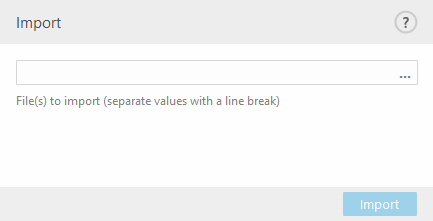Create new list
The list will include the desired URL addresses/domain masks that will be blocked, allowed or excluded from checking. When creating a new list, specify the following:
•Address list type – Choose the type (Excluded from checking, Blocked or Allowed) from the drop-down list.
•List name – Specify the name of the list. This field will be grayed out when editing one of the three pre-defined lists.
•List description – Type a short description for the list (optional). Will be grayed out when editing one of three pre-defined list.
•List active – Use the switch to deactivate the list. You can activate it later when required.
•Notify when applying – If you want to be notified when a specific list is used in evaluation of an HTTP / HTTPS site that you visited. A notification will be issued if a website is blocked or allowed because it is included in the list of blocked or allowed addresses. The notification will contain the name of the list containing the specified website.
•Logging severity – Choose the logging severity (None, Diagnostic, Information or Warning) from the drop-down list. Records with Warning verbosity can be collected by ESET PROTECT.
ESET Security for Microsoft SharePoint enables user to block access to specified websites and prevent the web browser from displaying their content. Furthermore, it allows user to specify addresses, which should be excluded from checking. If the complete name of the remote server is unknown, or the user want to specify a whole group of remote servers, so-called masks can be used to identify such a group.
The masks include the symbols ? and *:
•use ? to substitute a symbol
•use * to substitute a text string
*.c?m applies to all addresses where the last part begins with the letter c, ends with the letter m and contains an unknown symbol in between them (.com, .cam, etc.). |
A leading *. sequence is treated specially if used at the beginning of a domain name. First, the * wildcard cannot represent a slash character ('/') in this case. This is to avoid circumventing the mask, for example the mask *.domain.com will not match https://anydomain.com/anypath#.domain.com (such a suffix can be appended to any URL without affecting the download). And second the *. also matches an empty string in this special case. This is to make it possible to match the whole domain, including any subdomains using a single mask. For example the mask *.domain.com also matches https://domain.com. Using *domain.com would be incorrect, as that would also match https://anotherdomain.com.

Enter multiple values
Add multiple URL addresses delimited by new lines, commas or semicolons. When multiple selection is enabled, addresses will be shown in the list.
Import
Text file with URL addresses to import (separate values with a line break, for example *.txt using encoding UTF-8).
